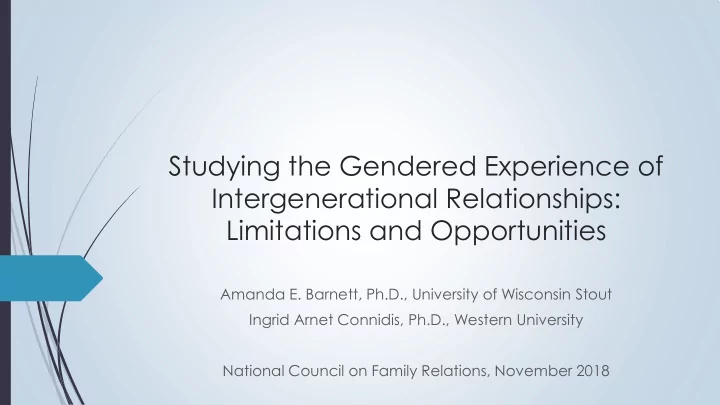

Studying the Gendered Experience of Intergenerational Relationships: Limitations and Opportunities Amanda E. Barnett, Ph.D., University of Wisconsin Stout Ingrid Arnet Connidis, Ph.D., Western University National Council on Family Relations, November 2018
Introduction Intergenerational ties in later life influenced by structured social relations (Matthews, 2002; Stelle et al., 2010) Feminine bias in conceptualization & study of these ties (Mann, 2007; Matthews, 2002; 2005; Stelle, et al., 2010; Timonen & Arber, 2012) Needed: A gender inclusive approach to intergenerational ties
Conceptual Framework Combined elements of (Connidis, 2010, 2012, 2015; Connidis & Barnett, 2019) : Life course perspective Critical perspective Feminist perspective Concept of ambivalence Micro-, meso-, & macro levels of analysis (Allen & Henderson, 2017; Baars et al., 2006; Calasanti, 2009; Connidis & Walker, 2009; Dannefer & Kelley-Moore, 2009; Holstein & Minkler, 2012; Huinink & Feldhaus, 2009)
Life Course Perspective Family ties & gender relations across life course Historical & social time Life stage Linked lives
Critical and Feminist Perspectives Inequality of structured social relations has consequences for social institutions & family life Agency within the constraints & opportunities of structured social relations Status quo versus change
Concept of Ambivalence Contradiction & paradox in Intergenerational ties Institutional arrangements Structured social relations
A Critical Literature Review Women more available than men as parents & grandparents (Leopold & Skopek, 2015; Margolis, 2016; Margolis & Wright, 2017; Metlife, 2011) Women more involved with & emotionally close to their intergenerational ties (Barnett et al., 2010; Davey et al., 2009; Fuller-Thompson et al., 2014; Geurts et al., 2009; Grigoryeva, 2017; Harrington-Meyer, 2014; Mahne & Huxhold, 2012) Non-traditional women and men under- researched & misrepresented (Bates, 2009; Davidson et al., 2003; Mann, 2007; Matthews, 2002b, 2005; Matthews & Heidorn, 1998; Moore & Rosenthal, 2017; Stelle et al., 2010)
A Critical Literature Review More varied ways to be involved as a: grandfather (Bates, 2009; Bates & Goodsell, 2013; Goodsell et al., 2011; Moore & Rosenthal, 2017) grandmother (Hank et al., 2018; Harrington Meyer, 2014) adult son & daughter (Campbell, 2010)
A Critical Literature Review Intergenerational ambivalence linked to contradictions in social institutions & structures. Gendered work & pressures to meet needs of multiple generations (Chappell et al., 2015; Lahaie et al., 2013; Lin et al., 2012; Sarkisian & Gerstel, 2004) Changing expectations for work & family lives of women (Harrington-Meyer, 2014) Macro-level influences (Hagestad, 2009; Heinz et al., 2009; Herlofson & Hagestad, 2012; Marshall, 2009)
Directions for Future Research Research Questions Micro-, meso-, & macro level connections Linked lives & ambivalence
Directions for Future Research Methodological Approaches Representative samples & baseline data Research across families Comparative studies Research within families Multiple voices from multiple generations Multigenerational, multi-actor designs
Directions for Future Research Methodological Approaches ( Cont’d ) Longitudinal data Retrospective data Qualitative research Inclusion of historical and social context for different groups
Conclusion This conceptual framework advances our understanding of intergenerational ties in the 21 st century. Dynamic, multi-level A more inclusive view of women and men & their intergenerational relationships across the life course.
References Allen, K. R. & Henderson, A. C. (2017). Family theories: Foundations and applications. West Sussex, UK: Wiley Blackwell. Barnett, M. A., Scaramella, L. V., Neppl, T. K., Ontai, L., & Conger, R. D. (2010). Intergenerational relationship quality, gender, and grandparent involvement. Family Relations, 59 , 28-44. doi:10.1111/j.1741-3729.2009.00584. Baars, J., Dannefer, D., Phillipson, C., & Walker, A. (2006). Introduction: Critical perspectives in social gerontology. In J. Baars, D. Dannefer, C. Phillipson, & A. Walker (Eds.), Aging, globalization and inequality: The new critical gerontology (pp. 1-14). Amityville, NY: Baywood. Bates, J. S. (2009). Generative grandfathering: A conceptual framework for nurturing grandchildren. Marriage and Family Review, 45 , 331-352. doi:10.1080/01494920802537548 Bates, J. S., & Goodsell, T. L. (2013). Male kin relationships: Grandfathers, grandsons, and generativity. Marriage & Family Review, 49 , 26-50. doi: 10.1080/01494929.2012.728555 Calasanti, T. M. (2009). Theorizing feminist gerontology, sexuality, and beyond: An intersectional approach. In V. L. Bengtson, D. Gans, N. M. Putney, & M. Silverstain (eds), Handbook of Theories of Aging , 2 nd ed (pp. 471-485). New York: Springer. Campbell, L. D. (2010). Sons who care: Examining the experience and meaning of filial caregiving for married and never married sons. Canadian Journal on Aging 29:73–84. doi:10.1017/S071498080999033X Chappell, N. L., Dujela, C., & Smith, A. (2015). Caregiver well-being: Intersections of relationship and gender. Research on Aging 37:623–645. doi:10.1177/0164027514549258 Connidis, I. A. (2010). Family ties and aging (2 nd ed.). Thousand Oaks, CA: Sage. Connidis, I. A. (2012). Theoretical directions for studying family ties and aging. In R. Blieszner & V. Hilkevitch Bedford (Eds.), Handbook on Families and Aging (pp. 35-60). Santa Barbara, CA: Praeger. Connidis, I. A. (2015). Exploring ambivalence in family ties: Progress and prospects. Journal of Marriage and Family , 77 , 77-95. doi:10.1111/jomf.12150 Connidis, I. A., & Barnett, A. E. (2019). Family Ties & Aging (3 rd edition). Thousand Oaks, CA: Sage. Connidis, I. A., & Walker, A. J. (2009). (Re)visioning aging families: Gender, age, and aging in families. In S. A. Lloyd, A. L. Few, & K. R. Allen (Eds.), Handbook of feminist family studies (147-159) . Thousand Oaks, CA: Sage. Dannefer, D., & Kelley-Moore, J. A. (2009). Theorizing the life course: New twists in the paths. In V. L. Bengtson, D. Gans, N. M. Putney, & M. Silverstain (eds), Handbook of Theories of Aging , 2 nd ed (pp. 389-411). New York: Springer Davey, A., Savla, J., Janke, M., & Anderson, S. (2009). Grandparent-grandchild relationships: From families in contexts to families as contexts. International Journal of Aging and Human Development, 69 , 311-325. doi: 10.2190/AG.69.4.d
Recommend
More recommend